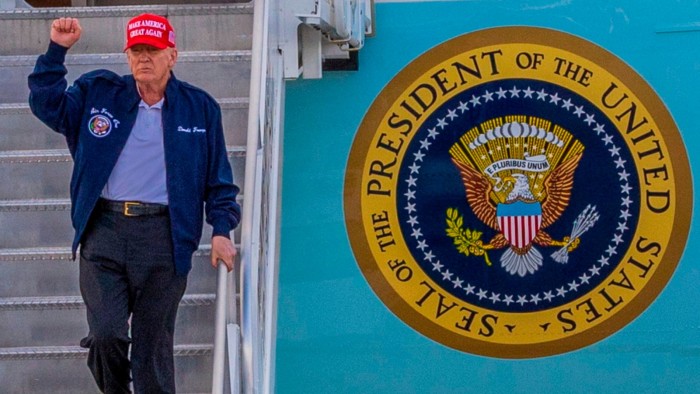As the transatlantic alliance unravels before our eyes, the ups and downs (mostly ups) in markets give the impression investors are humming a tune: “It’s the end of the world as we know it, and I feel fine.”
Matters of war and peace have, of course, dominated the week’s news. Donald Trump and his administration have picked a side in the conflict in Ukraine, and to the astonishment of Europe, it is Russia’s.
Trump’s assertions that Ukraine is at fault for Russia’s invasion and that its president, Volodymyr Zelenskyy, is a dictator, mark a shocking nadir for the postwar order. The alliances that have sought to keep the peace for decades are at best disrupted and deeply damaged.
And yet, at first flush, it appears that investors are saying “la la la, can’t hear you”. Major markets are performing well, and many typical signs of fear are absent. The question that keeps cropping up is when this trend will break.
It is not unusual for markets to remain upbeat when geopolitics resemble a bin fire. The grim attack on Israel in 2023 and subsequent pummelling of Gaza left no serious impact on most investors’ portfolios, for example, despite the tensions with Iran.
Investors, even professional ones, are people, too. It’s not that they don’t care about human suffering, or the risk of it. It’s just that conflicts are generally too well contained in smaller markets to drag down their performance. Nonetheless, the relentlessly cheerful tone in markets right now is jarring.
US stocks hit a record high earlier this week, with the S&P 500 index reaching above 6,100. At the more bullish end of the spectrum, research house Capital Economics has reiterated its call for the index to hit 7,000 by the end of the year, describing the target as “comparatively conservative”.
How about the classic hidey-holes that investors seek out in times of geopolitical stress? US government bonds are doing reasonably well after a shaky start to 2025, but they are not blasting higher, leaving 10-year yields in the region of 4.5 per cent. The Swiss franc — a key barometer of market nerves — is going the best part of nowhere this year, and the Japanese yen is up, but for domestic reasons, not as a global shock absorber.
On many measures, investors are flat-out bullish. Bank of America’s latest regular survey of portfolio managers is based on responses gathered before the most recent deterioration in global relations, but it still captures the hair-raising early weeks of Trump 2.0. It shows investors running their lowest allocation to cash — again a retreat for the faint of heart — in 15 years, at 3.5 per cent of portfolios.
The message is to keep calm and carry on, to keep the focus on the global economy. “While we expect volatility to pick up in the near term amid a range of macro uncertainties, favourable fundamentals should continue to support global equities’ next leg up,” wrote Solita Marcelli, chief investment officer for the Americas at UBS’s wealth management division.
It does not take a deep scratch beneath the surface, however, to uncover the nerves.
“Markets are consistently seeming to adopt the most benign interpretation of each and every headline,” said Matt King at Satori Insights. “Yet the assets doing the rallying have seldom been those most investors expected. US exceptionalism can be seen everywhere except in markets.”
Yes, US stocks are at a record high. But, in a rare sight, Europe is streaking ahead of them. So the S&P 500 has gained a little under 4 per cent so far this year — very solid. But even in dollars, the UK’s FTSE 100 is up 6.6 per cent and most European indices are well in to double figures, with defence stocks off to the races. This represents a meaningful rotation out of the US and in to Europe — the precise opposite of that American exceptionalism we were all led to believe would dominate the investment landscape for the year.
BofA’s survey shows a huge leap in the proportion of investors expecting global equities to be the best-performing asset class of the year, and a similarly huge decline in those expecting the US to lead the way. French bank Société Générale is touting Sunday’s elections in Germany as the start of a “new chapter” for European markets, leaving the region in a position to close the vast gap in valuations with the US.
Meanwhile, the price of the oldest and best safe retreat of them all — gold — is absolutely ripping higher, despite reasonably generous yields on offer from US Treasuries. The shiny stuff is up 12 per cent so far this year, adding to the 27 per cent gains of 2024 and taking out numerous record highs.
UK precious metals broker Sharps Pixley wrote excitedly this week about how gold has “sprinted” in to 2025. “Trump’s presidency has brought with it considerable uncertainty and angst, increasing demand for gold as a safe haven,” it said. Uncertainty and angst — music to a gold bug’s ears.
The performance of US markets is not bad enough to force a change of direction from the new president, but it is exceptional for the wrong reasons. Investors are taking note, and quietly tiptoeing away.
https://www.ft.com/content/1cce829b-bc56-4609-8fc6-82ebece8b8d5



